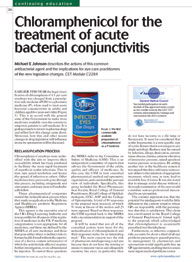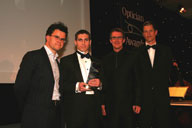As CET became a statutory necessity in mid-2005, Optician was pleased to expand the range of CET accredited articles offered to readers. However, this meant there was much stiffer competition for the CET article of the year award.
 As in previous years, our judges came from a range of backgrounds, including hospital, private practice, and business and academic institutions. Several factors were considered by the panel.
As in previous years, our judges came from a range of backgrounds, including hospital, private practice, and business and academic institutions. Several factors were considered by the panel.
Obviously, the originality and usefulness of the article was important, as was the clarity with which the information was presented. The use of original or unusual graphics or illustrations was also considered, along with the overall presentation.
While the number of respondents may arguably not be the best way to judge an article - given a specialised piece may attract fewer respondents than a general work - these numbers were also included in the information to the judges. The judges agreed that the article on chloramphenical by Michael Johnson was a strong piece, and scored it well in all areas.
One judge commented the piece was 'an excellent and clear summary of the use of this drug at a time when increasing numbers of practitioners were likely to want to supply it'.
At the same time that the CET rules were changing, there were also developments in the way optometrists could sell and supply 'pharmacy' categorised medicines. Chloramphenicol, the broad spectrum antibiotic commonly used for acute bacterial conjunctivitis, was made available in a P category formulation, so Johnson's article was timely in explaining the indications for its use, mode of action, and clinical appraisal.
Feedback from readers suggested that the article was likely to be referred to as they became more confident in managing external ocular infections.
Author profile
 Johnson graduated from Cardiff University with a first class degree and undertook his pre-registration year at Moorfields Eye Hospital. Qualifying as an optometrist in 2001 - after obtaining both the President's and BCLA prizes in the PQEs - he returned to Wales and initially worked in private practice. He later returned to university as a part-time PhD student to investigate the effect of laser refractive surgery on the ocular tear film.
Johnson graduated from Cardiff University with a first class degree and undertook his pre-registration year at Moorfields Eye Hospital. Qualifying as an optometrist in 2001 - after obtaining both the President's and BCLA prizes in the PQEs - he returned to Wales and initially worked in private practice. He later returned to university as a part-time PhD student to investigate the effect of laser refractive surgery on the ocular tear film.
'Currently, my time is split between research and teaching at Cardiff University and as a senior optometrist at Bristol Eye Hospital,' Johnson explains. 'I have published several peer-reviewed papers on the anterior eye. While this is the thrust of my research, I aim to have a balanced knowledge across the spectrum of optometry. I have a College diploma in orthoptics and I am part-way through one for glaucoma, but feel my main strength is in the fitting of medical contact lenses and the communication of complex ideas to patients.'
Outside of optometry Johnson escapes the city to run on trails or enjoy the rugged Welsh mountainside with friends. He is the current Welsh University cross-country running champion and the outgoing men's captain of the Cardiff University athletics team.
'The Optician award was a surprise,' he says. 'I was not aware I had been entered until I received an invitation to the ceremony. It is always a fear when you write something that no one will ever read it, and even more so that those who do will not like it, so it was great to get such an accolade from my peers. The evening itself was quite something for a country boy, thoroughly enjoyable.'
Optician will be publishing more work related to Michael Johnson's research in the new year.
